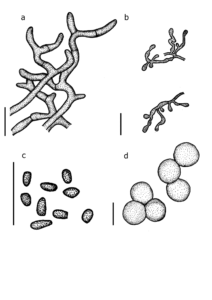Fungalpedia – Note 245, Myotisia
Myotisia Kubátová, M. Kolařík & Hubka.
Citation when using this entry: Thakshila et al. 2024 (in prep) – Fungalpedia, Onygenales, Eurotiales, and Verrucariales.
Index Fungorum, Facesoffungi, MycoBank, GenBank, Fig. 1
Classification: Onygenaceae, Onygenales, Eurotiomycetidae, Eurotiomycetes, Fungi
The monotypic genus, Myotisia was introduced by Crous et al. (2017). This genus is typified by M. cremea, which was isolated from bat droppings of Myotis myotis in an underground tunnel of Malá Amerika mine, Czech Republic (Crous et al. (2017). Both asexual and sexual states have been reported. Based on phylogenetic analysis of the LSU sequence, Myotisia groups with Arachnotheca glomerata. However, M. cremea is morphologically different from A. glomerata from its smooth-walled ascospores (Crous et al. 2017). The sexual state of Myotisia is characterized by spherical, solitary, or clustered gymnothecial ascomata. The peridium has a network of hyaline-branched septate hyphae. Asci consists of eight hyaline ascospores, which are globose and smooth-walled. The asexual state is characterized by verruculose arthroconidia. Terminal arthroconidia are obovoid to ellipsoidal and intercalary arthroconidia are alternate or barrel-shaped to ellipsoidal (Crous et al. 2017).
Type species: Myotisia cremea Kubátová, M. Kolařík & Hubka
Figure 1– Myotisia cremea (CCF 5407, ex-type culture). a Peridial hyphae. b Malbranchea-like asexual morph. c Arthroconidia. d Ascospores. Scale bars: a–c = 20 μm, d = 2 μm. Redrawn from Crous et al. (2017).
References
Entry by
Subasingha A. D. Thakshila, Center of Excellence in Fungal Research, School of Science, Mae Fah Luang University, Chiang Rai 57100, Thailand
(Edited by Chitrabhanu S. Bhunjun, Kevin D. Hyde, Samaneh Chaharmiri-Dokhaharani, & Achala R. Rathnayaka)
Published online 22 April 2024
